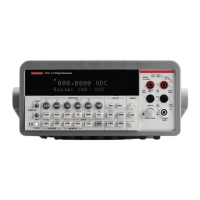mine which limit has failed, you will have to read the Measurement Event
Register.
Reading the results of a limit test does not clear the fail indication of the test.
A failure can be cleared by using a :CLEar command, or by disabling the test
(:STATe OFF).
:CLEar commands
[:IMMediate]
:CALCulate3:LIMit[1]:CLEar[:IMMediate] Clear LIMIT1 test failure
Description This action command is used to clear the fail indication of the LIMIT1 test.
Note that a failure is also cleared when the limit test is disabled (:STATe
OFF).
:AUTO <b>
:CALCulate3:LIMit[1]:CLEar:AUTO <b> Control auto- clear
Parameters <b> = 1 or ON Enable auto-clear for limit failure
0 or OFF Disable auto-clear for limit failure
Query :AUTO? Query state of auto-clear
Description With auto-clear enabled, the fail indication of a limit test clears when instru-
ment operation enters the idle state. With auto-clear disabled, the fail indi-
cation will remain until it is cleared by the :CLEar[IMMediate] command.
:IMMediate
:CALCulate3:IMMediate Perform CALC3
Description When you change the configuration of the limit test, the next reading is eval-
uated according to the new test configuration. If the instrument is not in a
continuous measurement mode (e.g., waiting for a manual trigger), the test
will not be performed until the next reading conversion occurs.
This action command allows you to re-process the current input data to test
new limits. For example, assume the instrument is in a non-continuous mea-
surement mode and requires a manual trigger to cause the next reading con-
version. Changing the test limits will not affect the last test result. However,
sending the :IMMediate command reprocesses the data and evaluates the
reading according to the new test limits. Note that sending the :IMMediate
command does not initiate a reading conversion.
Program PRINT #1, “output 16;:trig:sour bus” ‘ Place 2000 in one-shot mode
SLEEP 3 ‘ Wait three seconds
PRINT #1, “output 16;:calc:imm ‘ Re-perform limit test
SCPI Command Reference 5-25

